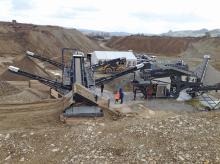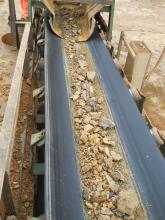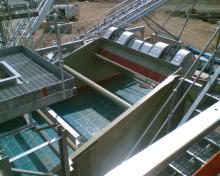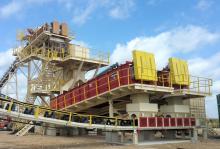For some years now the recycling of materials worldwide has been near the top of the environmental agenda but it can mean different things to different people. Depending on the country, what constitutes recycling will differ greatly. For example, in some instances simply crushing the material and taking it to landfill can be regarded as recycling, writes Patrick Smith.
But for one German company, involved in a project backed by the European Eco Innovation Fund, it means moving waste material up the value chain and seeing a financial return on that material having initially been paid to remove it.
Feess Urdbau is one of the major C&D waste recycling companies in the Stuttgart region, and at its Kirchheim plant is involved in the CANDY (CompAct, highly mobile, Next generation, CD&E waste recoverY system) project , a partnership between
The project aims to improve the infrastructure for the recycling of construction, demolition and excavation waste in Europe and seeks to promote environmental technologies that are widely adopted in one EU member state but are as yet relatively unknown in others.
Feess Urdbau receives a wide variety of waste and contaminated materials including that from road workings, railway ballast, old bricks and earthworks at the company’s recycling parks in Kirchheim and Ebersbach/Fils, near Stuttgart, and turns them into reusable products.
Aggregates and sand processed from the waste are used in the on-site factory to produce concrete blocks, many of which are used by the company to build walls, bases and product bunkers. Others, such as old railway ballast covered in oil and clay are processed and resold as railway ballast.
Feess Urdbau also used the concrete to construct a 200,000m³ rainwater collecting tank, and such are the company’s eco credentials that power at the park is produced from photovoltaic cells incorporated in the buildings.
The family business, celebrating 60 years of tradition, employs approximately 160 employees and its modern machinery and fleet includes around 30 trucks, 50 pieces of heavy equipment, including a number of
“We conducted extensive research into the European market as part of the project and identified Germany as the country where there is significant potential to move recycled sand and aggregates up the value chain,” says Peter Craven, Head of Marketing with CDE Global. “The introduction of a new construction, demolition and excavation recycling system will deliver on a number of key objectives including reduced plant footprint, enhanced mobility and an increased return on investment from CD & E recycling operations.” An open event will be held at the site from 16-18 September when the processes will be explained.
The CANDY project has only recently been commissioned, and Jakub Ziolkowski, a project engineer with CDE Global, has been responsible for overseeing installation. During the project’s 12-month duration there will be extensive material testing with local concrete producers to try and determine the optimum mix between virgin material and recycled content that can be used.
This will cover a wide range of concrete applications, and the process is being run in partnership with Stuttgart University. The end result will be a definitive report on the potential applications for recycled sand and aggregates and the appropriate mix ratio for each application.
Material from contractors, rail operations and the public are taken to Freess Urdbau’s 30,000m² site, and often they have to pay for this facility.
The Caterpillar wheeled loaders are among machines used to carry waste material from their bunkers or tips to the 20tonne capacity hopper of the R2500 screening unit of the CDE plant, which is handling some 100tonnes/hour but has recently been doing more.
“At present we have to feed this hopper every four minutes because the company is so busy,” says Jakub Ziolkowski, who points out that the plant is made up of four parts.
The R2500 is a new primary screening unit specifically designed to aid the feeding of troublesome materials to the CDE washing plants, and has only recently been launched, having been developed specifically for the CANDY project.
The primary screening unit allows direct feeding, screening and stockpiling of materials up to a capacity of 500tonnes/hour. (See also Equipment Update).
The R2500, which separates out a stockpile of oversize material that is bigger than 100mm, can be changed to two products because it has a double-deck screen, although it can also be a three-product machine.
The second phase of the operation involves the M2500, the mobile washing plant from CDE, integrating aggregate screening and sand washing on a single chassis. The product was originally launched at bauma Munich in 2010.
At the Feess Urdbau plant it is fed by a conveyor from the R2500 and will rinse materials to prepare them for washing. It also produces 45mm-200mm products from its double-deck screen.
Material from the M2500 smaller than 45mm goes to the CDE AggMax 83R portable logwasher, which allows for the primary screening and high attrition washing of claybound material through a combination of a RotoMax Logwasher and high frequency screening technology. It offers the option to remove the sand fraction prior to entering the RotoMax. Aggregate processed by the RotoMax is subject to severe attrition, thus ensuring the highest level of clay is removed.
After the scrubbing process the clean aggregate is discharged onto the secondary rinsing screen, which not only removes the sand fractions by means of spraybars but also dewaters the aggregate ready for further screening.
At the rear of the AggMax an optional trash screen can be integrated for applications where the removal of lightweight contaminants is required. All sand fractions and water are piped back to the EvoWash to ensure maximum sand recovery.
The project also includes a number of new product developments on the water treatment and filtration side including the new AquaCell Thickener from CDE, which is the latest development of the company’s AquaCycle system in a format that is more easily transported and quicker to install, taking up less space on site and delivering an improved sludge concentration.
The final element of this is achieved through the inclusion of a new sludge concentrator. The sludge management end is managed through the introduction of a decanter centrifuge.
Sludge, the only waste product during the recycling process, is discharged for disposal, while clean water retrieved is stored in the water tank for reuse.
“Dry crushing and screening dominates the CD & E waste processing market in Germany and we hope that this project will demonstrate the potential for washing this material to produce better quality recycled products with higher value applications,” says Jakub Ziolkowski, CDE Project Engineer.
Terex Finlay 883 Spaleck fires up recycling operation
A high-speed
The waste product is being put through the machine at the company’s site in Nottingham, central England, to produce road construction materials.
Supplied to Johnsons Aggregates and Recycling by Finlay Central, part of the
Central to the machine’s capability is the two-deck German designed and constructed screen-box.
The heavy-duty vibrating Spaleck screen is said to offer nearly blockage-free screening in the upper and lower deck thanks to tried and tested 3D and Flip-Flow technology.
“The 3D screening segments guarantee correct grain size with no long pieces or extraneous material for the tension shaft screen on the lower deck, while the Flip-Flow screen, featuring screwless mounted screen mats, avoids unnecessary cleaning,” says Finlay.
At Johnsons, the 883 Spaleck is products sized 10mm down, 10–50mm and 50mm up.
“It’s exactly what we want. The machine is versatile and can process extreme products that typically struggle through conventional screens,” says Steve Johnson, director and founder of Johnsons Aggregates and Recycling.
“The additional vibration enables the waste ash material to release itself, so it avoids clogs, and it also handles the product’s abrasive consistency.”










